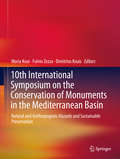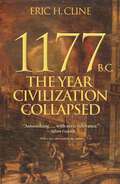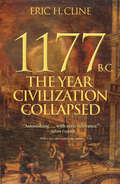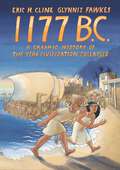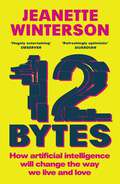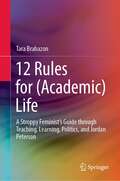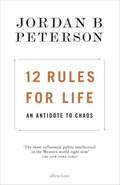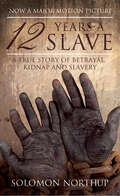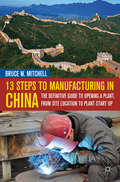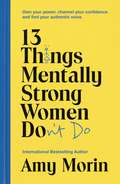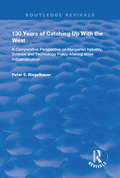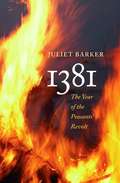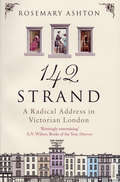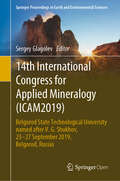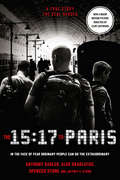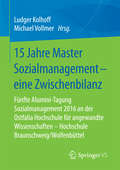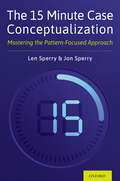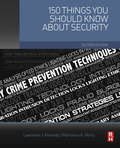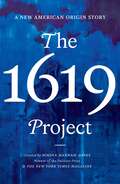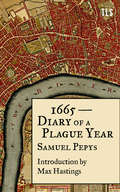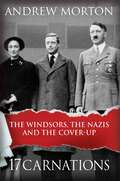- Table View
- List View
10th International Symposium on the Conservation of Monuments in the Mediterranean Basin: Natural and Anthropogenic Hazards and Sustainable Preservation
by Maria Koui Fulvio Zezza Dimitrios KouisThis book addresses physical, chemical, and biological methods for the preservation of ancient artifacts. Advanced materials are required to preserve the Mediterranean belt's historic, artistic and archaeological relics against weathering, pollution, natural risks and anthropogenic hazards. Based upon the 10th International Symposium on the Conservation of Monuments in the Mediterranean Basin, this book provides a forum for international engineers, architects, archaeologists, conservators, geologists, art historians and scientists in the fields of physics, chemistry and biology to discuss principles, methods, and solutions for the preservation of global historical artifacts.
1177 B.C.: The Year Civilization Collapsed: Revised and Updated (Turning Points in Ancient History #1)
by Eric ClineA bold reassessment of what caused the Late Bronze Age collapseIn 1177 B.C., marauding groups known only as the "Sea Peoples" invaded Egypt. The pharaoh's army and navy managed to defeat them, but the victory so weakened Egypt that it soon slid into decline, as did most of the surrounding civilizations. After centuries of brilliance, the civilized world of the Bronze Age came to an abrupt and cataclysmic end. Kingdoms fell like dominoes over the course of just a few decades. No more Minoans or Mycenaeans. No more Trojans, Hittites, or Babylonians. The thriving economy and cultures of the late second millennium B.C., which had stretched from Greece to Egypt and Mesopotamia, suddenly ceased to exist, along with writing systems, technology, and monumental architecture. But the Sea Peoples alone could not have caused such widespread breakdown. How did it happen?In this major new account of the causes of this "First Dark Ages," Eric Cline tells the gripping story of how the end was brought about by multiple interconnected failures, ranging from invasion and revolt to earthquakes, drought, and the cutting of international trade routes. Bringing to life the vibrant multicultural world of these great civilizations, he draws a sweeping panorama of the empires and globalized peoples of the Late Bronze Age and shows that it was their very interdependence that hastened their dramatic collapse and ushered in a dark age that lasted centuries.A compelling combination of narrative and the latest scholarship, 1177 B.C. sheds new light on the complex ties that gave rise to, and ultimately destroyed, the flourishing civilizations of the Late Bronze Age—and that set the stage for the emergence of classical Greece.
1177 B.C.: The Year Civilization Collapsed (Turning Points in Ancient History)
by Eric H. ClineIn 1177 B.C., marauding groups known only as the "Sea Peoples" invaded Egypt. The pharaoh's army and navy managed to defeat them, but the victory so weakened Egypt that it soon slid into decline, as did most of the surrounding civilizations. After centuries of brilliance, the civilized world of the Bronze Age came to an abrupt and cataclysmic end. Kingdoms fell like dominoes over the course of just a few decades. No more Minoans or Mycenaeans. No more Trojans, Hittites, or Babylonians. The thriving economy and cultures of the late second millennium B.C., which had stretched from Greece to Egypt and Mesopotamia, suddenly ceased to exist, along with writing systems, technology, and monumental architecture. But the Sea Peoples alone could not have caused such widespread breakdown. How did it happen?In this major new account of the causes of this "First Dark Ages," Eric Cline tells the gripping story of how the end was brought about by multiple interconnected failures, ranging from invasion and revolt to earthquakes, drought, and the cutting of international trade routes. Bringing to life the vibrant multicultural world of these great civilizations, he draws a sweeping panorama of the empires and globalized peoples of the Late Bronze Age and shows that it was their very interdependence that hastened their dramatic collapse and ushered in a dark age that lasted centuries.A compelling combination of narrative and the latest scholarship, 1177 B.C. sheds new light on the complex ties that gave rise to, and ultimately destroyed, the flourishing civilizations of the Late Bronze Age—and that set the stage for the emergence of classical Greece.
1177 B.C.: The Year Civilization Collapsed (Turning Points in Ancient History)
by Eric H. ClineIn 1177 B.C., marauding groups known only as the "Sea Peoples" invaded Egypt. The pharaoh's army and navy managed to defeat them, but the victory so weakened Egypt that it soon slid into decline, as did most of the surrounding civilizations. After centuries of brilliance, the civilized world of the Bronze Age came to an abrupt and cataclysmic end. Kingdoms fell like dominoes over the course of just a few decades. No more Minoans or Mycenaeans. No more Trojans, Hittites, or Babylonians. The thriving economy and cultures of the late second millennium B.C., which had stretched from Greece to Egypt and Mesopotamia, suddenly ceased to exist, along with writing systems, technology, and monumental architecture. But the Sea Peoples alone could not have caused such widespread breakdown. How did it happen?In this major new account of the causes of this "First Dark Ages," Eric Cline tells the gripping story of how the end was brought about by multiple interconnected failures, ranging from invasion and revolt to earthquakes, drought, and the cutting of international trade routes. Bringing to life the vibrant multicultural world of these great civilizations, he draws a sweeping panorama of the empires and globalized peoples of the Late Bronze Age and shows that it was their very interdependence that hastened their dramatic collapse and ushered in a dark age that lasted centuries.A compelling combination of narrative and the latest scholarship, 1177 B.C. sheds new light on the complex ties that gave rise to, and ultimately destroyed, the flourishing civilizations of the Late Bronze Age—and that set the stage for the emergence of classical Greece.
1177 B.C.: A Graphic History of the Year Civilization Collapsed
by Eric H. Cline Glynnis FawkesA beautiful, full-color graphic version of Eric Cline&’s bestselling 1177 B.C., adapted by award-winning author-illustrator Glynnis FawkesEric Cline&’s 1177 B.C. tells the story of one of history&’s greatest mysteries: what caused the ancient civilizations of the Aegean and Eastern Mediterranean to collapse more than three thousand years ago, bringing the Late Bronze Age to an abrupt end? In this vivid and captivating full-color graphic adaptation of the landmark book, author-illustrator Glynnis Fawkes invites us to follow two young friends living in the aftermath of the cataclysm as they unravel why it happened—and reveal important lessons for today&’s interconnected and vulnerable world.Pel, a member of the marauding Sea Peoples, and Shesha, an Egyptian scribe, visit the kingdoms of the Minoans, Mycenaeans, Hittites, Canaanites, Assyrians, and Egyptians to explore the calamities that brought them down. This graphic history depicts the people, events, art, architecture, and lands that Pel and Shesha encounter. We witness the Sea Peoples&’ battles on land and sea, earthquakes on the Greek mainland, droughts and famine in Anatolia, invasions in north Syria, and possible rebellions in Canaan. Along the way, we also learn about the assassination of a Hittite prince traveling to marry an Egyptian queen, the sinking of a merchant ship laden with international goods, and the return of a pair of sandals to Crete by the Babylonian king Hammurabi.An entertaining adventure story, this dazzling comic is also historically accurate and enlightening, inviting readers of all ages to think about the surprising factors and theories that explain why societies, whether ancient or modern, die or survive when struck by catastrophes.
12 Bytes: How We Got Here. Where We Might Go Next.
by Jeanette Winterson*A 'BOOKS OF 2021' PICK IN THE GUARDIAN, FINANCIAL TIMES AND EVENING STANDARD*Twelve bytes. Twelve eye-opening, mind-expanding, funny and provocative essays on the implications of artificial intelligence for the way we live and the way we love - from Sunday Times-bestselling author Jeanette Winterson. An original and entertaining new book from Jeanette Winterson, drawing on her years of thinking about and reading about Artificial Intelligence in its bewildering manifestations. She looks to history, religion, myth, literature, the politics of race and gender, and of course, computing science, to help us understand the radical changes to the way we live and love that are happening now. When we create non-biological life-forms, will we do so in our image? Or will we accept the once-in-a-species opportunity to remake ourselves in their image? What do love, caring, sex, and attachment look like when humans form connections with non-human helpers teachers, sex-workers, and companions? And what will happen to our deep-rooted assumptions about gender? Will the physical body that is our home soon be enhanced by biological and neural implants, keeping us fitter, younger, and connected? Is it time to join Elon Musk and leave Planet Earth? With wit, compassion and curiosity, Winterson tackles AI's most interesting talking points, from the algorithms that data-dossier your whole life, to the weirdness of backing up your brain.
12 Rules for (Academic) Life: A Stroppy Feminist’s Guide through Teaching, Learning, Politics, and Jordan Peterson
by Tara BrabazonThese are strange times. Climate crises. Health crises. Collapsing systems. Influencers. And yes - Jordan Peterson.We are currently living in a (Post) Peterson Paradigm. This book – 12 Rules for (Academic) Life - explores what has happened to teaching, learning and politics through this odd and chaotic intervention. Deploying feminism, this lens and theory offers a glass-sharpened view of this moment in international higher education. It is organized through twelve mantras for higher education in this interregnum, and offers new, radical, edgy and passionate methodologies, epistemologies and ontologies for a University sector searching for a purpose. This is a feminist book which targets a feminist audience, both inside and outside higher education. It presents a clear focus on how this Peterson moment can be managed and challenged, when in future such academics deploy social media in this way. This book is also a part of higher education studies, exploring the role of the public / critical / dissenting / organic intellectual in debates about the political economy, identity/politics and leadership.A question of our time – through a climate emergency, a pandemic and polarized politics – is why Professor Jordan Peterson gained profile and notoriety. The Jordan Peterson moment commenced in September 2016 with his YouTube video, “Professor against political correctness,” and concluded with his debate with Slavoj Zizek on April 19, 2019. From this moment, his credibility was dented, if not destroyed.Jordan Peterson infused scholarly debates with Punch and Judy extremism and misunderstandings. Instead, this book offers research rather than certainty, interpretation rather than dogma, evidence rather than opinion, and theory rather than ‘moral truth.’ The goal is to recalibrate this (Post) Peterson Paradigm, to take stock of how this moment occurred, and how to create a revision of higher education.
12 Rules for Life: An Antidote to Chaos
by Jordan B. PetersonJordan Peterson's work as a clinical psychologist has reshaped the modern understanding of personality, and now he has become one of the world's most popular public thinkers, with his lectures on topics ranging from the Bible to romantic relationships drawing tens of millions of viewers. In an era of polarizing politics, echo chambers and trigger warnings, his startling message about the value of personal responsibility and the dangers of ideology has resonated around the world.In this book, he combines ancient wisdom with decades of experience to provide twelve profound and challenging principles for how to live a meaningful life, from setting your house in order before criticising others to comparing yourself to who you were yesterday, not someone else today. Gripping, thought-provoking and deeply rewarding, 12 Rules for Life offers an antidote to the chaos in our lives: eternal truths applied to our modern problems.
12 Years a Slave: A True Story Of Betrayal Kidnap And Slavery (Hesperus Classics Ser.)
by Solomon NorthupA powerful and riveting condemnation of American slavery, 12 Years a Slave is the harrowing true story of Solomon Northup who was kidnapped and sold into slavery, enduring unimaginable degradation and abuse until his rescue twelve years later. Steve McQueen's powerful film adaptation starring Chiwetel Ejiofor, Brad Pitt, Michael Fassbender and Benedict Cumberbatch won Best Picture at both the Oscars and the Golden Globes in 2014.Tricked by two men offering him a job as a musician in New York State in 1841, Solomon Northup was drugged and kidnapped. His life is jeopardy, he was forced to assume a new name and fake past. Taken to Louisiana on a disease-ridden plague ship, he was initially sold to a cotton planter. In the twelve years that follow he is sold to many different owners who treat him with varying levels of savagery; forced labour, scant food and numerous beatings are his regular fare. Against all odds, Northup eventually succeeds in contacting a sympathetic party and manages to get word to his family. The ensuing rescue and legal cases are no less shocking and intriguing than the rest of the tale. A true-life testament to tremendous courage and tenacity in the face of unfathomable injustice, Northup's account also provides a rare insight into a murky past being meticulous first-hand recordings of slave life. A new film premiering in 2013, featuring Brad Pitt and Benedict Cumberbatch, is sure to introduce this amazing story to a new audience.
13 Steps to Manufacturing in China: The Definitive Guide to Opening a Plant, From Site Location to Plant Start-Up
by B. MitchellA comprehensive reference book providing the tactics, strategies, and methodology for establishing a manufacturing plant in China. The book is jam packed with details including sourcing Chinese equipment, importing used or new equipment, building construction, and permit requirements.
13 Things Mentally Strong Women Don't Do: Own Your Power, Channel Your Confidence, and Find Your Authentic Voice
by Amy MorinThe emergence of the #MeToo and #TimesUp movements have awakened society and encouraged women to find their voice and claim back their power. Contending with a host of difficult issues that demand psychological strength - in this crucial book, prominent psychotherapist and licensed clinical social worker Amy Morin gives women the techniques to build mental muscle in 13 steps.Delving into critical issues like sexism, social media, social comparison, and social pressure, Amy offers thoughtful, intelligent advice, practical tips, and specific strategies; combining them with her personal experiences, stories from former patients, and both well-known and untold examples from women from across industries and pop culture. Throughout, she explores the areas women - and society at large - must focus on to become (and remain) mentally strong.Amy reveals that healthy, mentally tough women don't insist on perfection; they don't compare themselves to other people; they don't see vulnerability as a weakness; they don't let self-doubt stop them from reaching their goals. Insightful, grounded, and extremely timely, 13 THINGS MENTALLY STRONG WOMEN DON'T DO can help every woman flourish - and Amy will take readers on this journey with her, every step of the way.
130 Years of Catching Up with the West: A Comparative Perspective on Hungarian Science and Technology Policy-making Since Industrialization (Routledge Revivals)
by Peter S BiegelbauerThis title was first published in 2000: Issues such as globalization and the fight against joblessness as well as the growth dynamics of economies in general have been linked with science and technology. Accordingly, the growing public interest in the effects of science and technology on society and politics and vice versa have been the foremost reason for the creation of this study. One of the central questions for politicians as well as for scholars in the field of science and technology is, "How can I influence a given science and technology system in a way so as to achieve optimal outcomes for a given national economy?". The study at hand tries to answer this question by analyzing the Hungarian research sphere from industrialization until the late-20th century. Since the beginning of industrialization, Hungary has made a number of attempts to catch up with the economically more developed Western European countries. The problems encountered in the course of the Hungarian efforts are surprisingly similar to the difficulties that modern, fully industrialized economies are facing today.
130 Years of Catching Up with the West: A Comparative Perspective on Hungarian Science and Technology Policy-making Since Industrialization (Routledge Revivals)
by Peter S BiegelbauerThis title was first published in 2000: Issues such as globalization and the fight against joblessness as well as the growth dynamics of economies in general have been linked with science and technology. Accordingly, the growing public interest in the effects of science and technology on society and politics and vice versa have been the foremost reason for the creation of this study. One of the central questions for politicians as well as for scholars in the field of science and technology is, "How can I influence a given science and technology system in a way so as to achieve optimal outcomes for a given national economy?". The study at hand tries to answer this question by analyzing the Hungarian research sphere from industrialization until the late-20th century. Since the beginning of industrialization, Hungary has made a number of attempts to catch up with the economically more developed Western European countries. The problems encountered in the course of the Hungarian efforts are surprisingly similar to the difficulties that modern, fully industrialized economies are facing today.
1381: The Year of the Peasants' Revolt
by Juliet BarkerJuliet Barker provides an account of the first great popular uprising in England and a fascinating study of medieval life in English towns and countryside. She tells how and why an unlikely group of ordinary men and women from every corner of England united in armed rebellion against church and state to demand a radical political agenda.
1381: The Year of the Peasants' Revolt
by Juliet BarkerJuliet Barker provides an account of the first great popular uprising in England and a fascinating study of medieval life in English towns and countryside. She tells how and why an unlikely group of ordinary men and women from every corner of England united in armed rebellion against church and state to demand a radical political agenda.
142 Strand: A Radical Address in Victorian London
by Rosemary Ashton142 Strand was the home of the brilliant, unconventional young publisher John Chapman. All the daring and avant-garde writers and thinkers of Victorian London gathered here, among them Carlyle, Dickens, Thackeray; Americans like Emerson and refugees from revolutionary Europe like Mazzini. In 1851 Chapman brought Marian Evans - the future George Eliot - to London where her arrival caused rows in the household, which included Chapman's wife and also his mistress.The Strand was packed with booksellers, magazine publishers, theatres, clubs, and quack doctors. Only a short distance away were Westminster, the Houses of Parliament and the disreputable pornographers of Holywell street. Chapman's circle touched all these worlds, and the vivid story of these unconventional lives and unorthodox views - marvellously told by Rosemary Ashton - takes us to the heart of Victorian culture, uncovering its surprising energy, its doubts and arguments, and, above all, its passionate reforming spirit.
14th International Congress for Applied Mineralogy: Belgorod State Technological University named after V. G. Shukhov, 23–27 September 2019, Belgorod, Russia (Springer Proceedings in Earth and Environmental Sciences)
by Sergey GlagolevThis open access proceedings of the 14th International Council for Applied Mineralogy Congress (ICAM) in Belgorod, Russia cover a wide range of topics including applied mineralogy, advanced and construction materials, ore and industrial minerals, mineral exploration, cultural heritage, etc. It includes contributions to geometallurgy, industrial minerals, oil and gas reservoirs as well as stone artifacts and their preservation. The International Congress on Applied Mineralogy strengthens the relation between the research on applied mineralogy and the industry.
The 15: The True Story Of A Terrorist, A Train And Three American Heroes
by Anthony Sadler Alek Skarlatos Spencer StoneThe 15:17 to Paris is the amazing true story of friendship and bravery, and of near tragedy averted by three heroic young men who found the unity and strength inside themselves when they – and 500 other innocent travellers – needed it most.
15 Jahre Master Sozialmanagement – eine Zwischenbilanz: Fünfte Alumini-Tagung Sozialmanagement 2016 an der Ostfalia Hochschule für angewandte Wissenschaften - Hochschule Braunschweig/Wolfenbüttel
by Ludger Kolhoff Michael VollmerDie Dokumentation zieht eine Zwischenbilanz des ersten in Deutschland akkreditierten Studiengangs Sozialmanagement an der Ostfalia vor fünfzehn Jahren. Neben Beispielen zur Etablierung des weiterbildenden Fernstudiengangs wird der Diskussionsstand um das Feld Sozial- und Public Management gekennzeichnet.
The 15 Minute Case Conceptualization: Mastering the Pattern-Focused Approach
by Jonathan Sperry Len SperryOnce understood as useful but optional, case conceptualization is now considered essential and one of the most important of all clinical skills and competencies. As clinicians look for resources to assist in learning and mastering this competency, they must choose among different case conceptualization approaches considering those that are both clinically effective and clinician friendly. A truly clinically effective approach explains and guides treatment, and most importantly, predicts challenges and obstacles that are likely to arise over the course of treatment. Most approaches emphasize explaning and guiding treatment, but seldom include third function which helps anticipate likely challenges, which if not proactively addressed, are likely to result in therapy interference or premature termination. Research shows that such case conceptualization is essential in determining the course and overall effectiveness of therapy. This essential task can be completed in as little as fifteen minutes. A truly clinician-friendly approach is one that is quick to use and easy to master. The 15 Minutes Case Conceptualization is evidence-based, step-by-step approach that is both highly effective and clinician friendly.
The 15 Minute Case Conceptualization: Mastering the Pattern-Focused Approach
by Len Sperry Jonathan SperryOnce understood as useful but optional, case conceptualization is now considered essential and one of the most important of all clinical skills and competencies. As clinicians look for resources to assist in learning and mastering this competency, they must choose among different case conceptualization approaches considering those that are both clinically effective and clinician friendly. A truly clinically effective approach explains and guides treatment, and most importantly, predicts challenges and obstacles that are likely to arise over the course of treatment. Most approaches emphasize explaning and guiding treatment, but seldom include third function which helps anticipate likely challenges, which if not proactively addressed, are likely to result in therapy interference or premature termination. Research shows that such case conceptualization is essential in determining the course and overall effectiveness of therapy. This essential task can be completed in as little as fifteen minutes. A truly clinician-friendly approach is one that is quick to use and easy to master. The 15 Minutes Case Conceptualization is evidence-based, step-by-step approach that is both highly effective and clinician friendly.
150 Things You Should Know about Security
by Marianna Perry Lawrence J. Fennelly150 Things You Should Know about Security, Second Edition covers the essential tips and techniques for the latest trends in physical security. This indispensable guide further covers the latest technological trends for managing the security needs of all kinds, from physical and corporate security, to the latest cybersecurity threats. Through anecdotes, case studies, and documented procedures, the authors have amassed the most complete collection of information on security available. Security professionals will find this book easy to use and understand when seeking practical tips for managing the latest security technologies, such as bio-metrics, IP video, video analytics, and more. Several themes have been included, such as management principles and styles, communications, security applications, investigations, technology, physical security, the future, and many more. In addition, tips for quantifying the reduction and prevention of crime, loss and liability risks are included, assisting security professionals in securing corporate resources for security manpower and infrastructure.Provides essential, practical tips on a seemingly infinite number of security topics, allowing busy security professionals quick access to the information they needBlends theory and practice with a specific focus on today’s global business and societal environment and the various security, safety and asset protection challengesProvides tips on how to utilize the growing field of crime prevention through environmental design (CPTED)
The 1619 Project: A New American Origin Story
by Nikole Hannah-Jones The New York Times MagazineA dramatic expansion of a groundbreaking work of journalism, The 1619 Project: A New American Origin Story offers a profoundly revealing vision of the American past and present.In late August 1619, a ship arrived in the British colony of Virginia bearing a cargo of twenty to thirty enslaved people from Africa. Their arrival led to the barbaric and unprecedented system of American chattel slavery that would last for the next 250 years. This is sometimes referred to as the country's original sin, but it is more than that: It is the source of so much that still defines the United States.The New York Times Magazine's award-winning "1619 Project" issue reframed our understanding of American history by placing slavery and its continuing legacy at the center of our national narrative. This new book substantially expands on that work, weaving together eighteen essays that explore the legacy of slavery in present-day America with thirty-six poems and works of fiction that illuminate key moments of oppression, struggle, and resistance. The essays show how the inheritance of 1619 reaches into every part of contemporary American society, from politics, music, diet, traffic, and citizenship to capitalism, religion, and our democracy itself.This is a book that speaks directly to our current moment, contextualizing the systems of race and caste within which we operate today. It reveals long-glossed-over truths around our nation's founding and construction-and the way that the legacy of slavery did not end with emancipation, but continues to shape contemporary American life.Featuring contributions from: Leslie Alexander Michelle Alexander Carol Anderson Joshua Bennett Reginald Dwayne Betts Jamelle Bouie Anthea Butler Matthew Desmond Rita Dove Camille Dungy Cornelius Eady Eve L. Ewing Nikky Finney Vievee Francis Yaa Gyasi Forrest Hamer Terrance Hayes Kimberly Annece Henderson Jeneen Interlandi Honorée Fanonne Jeffers Barry Jenkins Tyehimba Jess Martha S. Jones Robert Jones, Jr. A. Van Jordan Ibram X. Kendi Eddie Kendricks Yusef Komunyakaa Kevin Kruse Kiese Laymon Trymaine Lee Jasmine Mans Terry McMillan Tiya Miles Wesley Morris Khalil Gibran Muhammad Lynn Nottage ZZ Packer Gregory Pardlo Darryl Pinckney Claudia Rankine Jason Reynolds Dorothy Roberts Sonia Sanchez Tim Seibles Evie Shockley Clint Smith Danez Smith Patricia Smith Tracy K. Smith Bryan Stevenson Nafissa Thompson-Spires Natasha Trethewey Linda Villarosa Jesmyn Ward
1665 – Diary of a Plague Year
by Samuel PepysWelcome to London in lockdown – in 1665 This timely release of a year in the life of London’s greatest diarist comes with an introduction by bestselling author, Max Hastings.
17 Carnations: The Windsors, The Nazis and The Cover-Up
by Andrew MortonThe true story of Edward Windsor and Wallis Simpson’s involvement with the Nazi regime, and the post-war cover-up.The story of the love affair between Wallis Simpson and King Edward VIII, and his abdication, has provoked endless fascination. However, the full story of their links with the German aristocracy and Hitler has remained untold.* 17 Carnations chronicles Hitler’s attempts to matchmake between Edward and a German noblewoman, and Wallis’s affair with the German foreign minister, who sent her a carnation for every night they had spent together. *Pro-German sympathizers, the couple became embroiled in a conspiracy to install Edward as a puppet king after the Allies’ defeat.* The Duke’s letters were hidden for years as the British establishment attempted to cover up the connection between the House of Windsor and Hitler.Thoroughly researched, 17 Carnations reveals the whole fascinating story, throwing sharp new light on this dark chapter of history.
